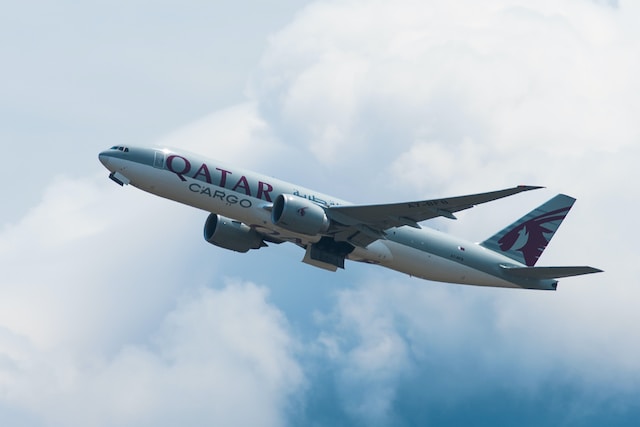Before we dive deep into the PESTEL analysis, let’s get the business overview of Qatar Airways. Qatar Airways is the state-owned flag carrier of Qatar, headquartered in the Qatar Airways Tower in Doha. The airline was founded in 1993 and began operations in 1994.
Network & Fleet: Qatar Airways operates a hub-and-spoke network, linking over 150 international destinations across Africa, Asia, Europe, the Americas, and Oceania from its base at Hamad International Airport in Doha. The airline has a diverse fleet, including various aircraft types ranging from the Boeing 777 and 787 series to the Airbus A350, A380, and A320 families.
Joint Ventures & Alliances: Qatar Airways is a member of the Oneworld alliance, partnering with major global airlines to offer passengers extended networks and benefits. The airline has also entered into several codesharing agreements with airlines outside the alliance.
Subsidiaries & Investments: Apart from passenger services, Qatar Airways has other business interests. It owns a subsidiary, Qatar Airways Cargo, which operates a substantial fleet of freighter aircraft and serves a global network. Additionally, the airline has made several investments in other global carriers and holds significant stakes in airlines like IAG (parent company of British Airways), LATAM, Cathay Pacific, etc.
Financial & Operation performance: Qatar Airways Group reported a net profit of QAR 4.4 billion (US$ 1.21 billion) during the fiscal year 2022/23. Overall revenue increased to QAR 76.3 billion (US$ 21.0 billion), up 45% compared to last year. Passenger revenue increased by 100% over last year, on a capacity increase of 31% driven by nine percent higher yields and a load factor of 80% – both the highest in the airline’s history, resulting in a sustainable increase in market share. Qatar Airways carried 31.7 million passengers, an increase of 71% over last year.
Here is the PESTEL analysis of Qatar Airways
A PESTEL analysis is a strategic management framework used to examine the external macro-environmental factors that can impact an organization or industry. The acronym PESTEL stands for:
- Political factors: Relate to government policies, regulations, political stability, and other political forces that may impact the business environment.
- Economic factors: Deal with economic conditions and trends affecting an organization’s operations, profitability, and growth.
- Sociocultural factors: Relate to social and cultural aspects that may influence consumer preferences, lifestyles, demographics, and market trends.
- Technological factors: Deal with developing and applying new technologies, innovations, and trends that can impact an industry or organization.
- Environmental factors: Relate to ecological and environmental concerns that may affect an organization’s operations and decision-making.
- Legal factors: Refer to the laws and regulations that govern businesses and industries.
In this article, we will do a PESTEL Analysis of Qatar Airways.
PESTEL Analysis Framework: Explained with Examples
Political
- Diplomatic Crisis in the Gulf Region: The political blockade initiated by Saudi Arabia, UAE, Bahrain, and Egypt in 2017 had significant implications for Qatar Airways. The blockade restricted Qatar Airways from using the airspace of these countries, leading to longer flight routes and increased operational costs. While the blockade has been lifted as of January 2021, the political ramifications of such moves impact airline operations.
- Government Ownership: Being a state-owned entity, Qatar Airways benefits from the Qatari government’s strong financial backing and support. This can be advantageous during tough economic times or industry downturns.
- International Relations: Qatar’s political relationships with other nations influence the airline’s expansion strategies. Positive bilateral ties can increase flight frequencies, new routes, and beneficial aviation agreements.
- Aviation Agreements: Bilateral air service agreements between Qatar and other nations dictate the frequency, capacity, and routes that Qatar Airways can operate. Such agreements can either enhance or limit the airline’s international expansion plans.
- Political Stability in Operating Regions: The political stability of countries to which Qatar Airways flies affects the airline’s operations. Civil unrest, political upheavals, or terrorist activities in destination countries can reduce demand or suspend operations.
- Regulations and Policies: Political decisions related to aviation regulations, airport charges, safety standards, and emissions can impact the airline’s operations. For instance, European policies on carbon emissions and the resultant charges can influence Qatar Airways’ operations in the region.
- Trade Wars and Tariffs: Political tensions leading to trade wars, like the U.S.-China trade war, can affect global travel demand and, consequently, airline traffic. Even though Qatar Airways may not be directly involved, the ripple effects of such events can influence its passenger and cargo business.
Economic
- Global Economic Health: The overall health of the global economy significantly influences the demand for air travel. Economic growth increases business travel, tourism, and trade, benefitting airlines like Qatar Airways.
- Exchange Rate Fluctuations: Being an international carrier, Qatar Airways deals with multiple currencies. Fluctuations in exchange rates can impact the airline’s revenues, costs, and profitability.
- Oil Prices: Fuel is a major cost component for any airline. The volatility of oil prices directly impacts Qatar Airways’ operational costs. While they may hedge fuel prices somewhat, prolonged high oil prices can increase ticket prices and potentially reduce demand.
- Income Levels and Consumer Spending: Higher disposable incomes in key markets can increase travel frequency, benefiting premium airlines like Qatar Airways that offer luxury travel experiences.
- Competition and Price Wars: Economic challenges in the airline industry often lead to price wars, with airlines reducing ticket prices to attract passengers. This can squeeze margins and affect profitability.
- Tourism Trends: Economic factors in popular tourist destinations, like visa regulations, infrastructure development, or promotional activities, can influence the demand for flights to those locations.
- Cargo and Trade: Economic activities in countries Qatar Airways operates in affect the demand for cargo services. Trade agreements, embargoes, or economic slowdowns in key markets can influence the volume and profitability of the airline’s cargo business.
- Economic Impacts of Pandemics: The COVID-19 pandemic illustrated how global health crises could devastate the airline industry. Reduced travel demand, border closures, and quarantine measures led to significant financial losses for many airlines, including Qatar Airways.
Sociocultural
- Cultural Attitudes towards Air Travel: The perception and acceptability of air travel in various cultures can affect demand. Some societies prioritize air travel as a preferred mode of transport, while others might be more hesitant due to cultural or religious reasons.
- Shift in Travel Preferences: Changing preferences, such as an increasing demand for experiential travel or eco-tourism, can influence the destinations and services Qatar Airways might consider.
- Safety and Security Concerns: Societal concerns about safety, especially after high-profile incidents or terror attacks, can impact the volume of travelers. Qatar Airways, like other airlines, must ensure and communicate the safety of its operations to assure passengers.
- Demand for Luxury and Comfort: As a premium airline, Qatar Airways caters to passengers seeking luxury and comfort. Recognizing and adapting to evolving standards of luxury in different cultures is crucial.
- Language and Communication: Being an international airline, understanding and respecting language nuances and ensuring multilingual staff, especially in-flight and at key international hubs, is essential.
- Cultural Events and Festivals: Recognizing and capitalizing on major cultural events, festivals, or sporting events in various countries can increase flight demand. As the national carrier of the State of Qatar, the FIFA World Cup Qatar 2022™ proved to the world its agile response by transporting 1.4 million passengers to the hugely successful event on its network.
Technological
- In-flight Entertainment and Connectivity: The demand for state-of-the-art in-flight entertainment systems and Wi-Fi connectivity has surged. To maintain its premium status, Qatar Airways continuously invests in updating its in-flight entertainment and providing onboard internet services.
- Digital Transformation: Online ticket booking, web check-in, mobile applications, and customer service chatbots have transformed the passenger experience. Investing in seamless digital platforms can enhance customer satisfaction and streamline operations.
- Aircraft Technology: Adopting newer, fuel-efficient aircraft can save costs and reduce environmental impact. For example, including the Airbus A350 and Boeing 787 Dreamliner in their fleet offers better fuel efficiency and a longer range.
- Data Analytics: Leveraging big data can help the airline understand passenger preferences, optimize flight routes, set dynamic pricing, and predict maintenance needs.
- Safety and Security Technologies: Implementing advanced security systems, from biometric scanning to advanced baggage screening technologies, can enhance safety and speed up airport processes.
- Maintenance and Repair Overhaul (MRO) Innovations: Advanced predictive maintenance tools can reduce unexpected downtimes, ensuring better aircraft availability and safety.
- Virtual and Augmented Reality (VR/AR): Qatar Airways can utilize VR/AR to train its crew, take virtual aircraft tours for potential customers, or enhance in-flight entertainment.
- Blockchain: This technology can streamline operations by ensuring secure and transparent transactions, from ticketing to cargo tracking.
- Artificial Intelligence (AI) and Machine Learning (ML): AI can optimize flight routes based on real-time data, assist in dynamic pricing strategies, or personalize in-flight entertainment based on passenger preferences.
Environmental
- Carbon Emissions: The aviation industry is a significant contributor to carbon emissions. As international regulatory bodies and public awareness intensify their focus on climate change, Qatar Airways, like other carriers, faces pressure to reduce its carbon footprint.
- Fuel Efficiency: More fuel-efficient aircraft reduce carbon emissions and cut operational costs. Investing in newer aircraft models, such as the Airbus A350 or Boeing 787 Dreamliner, can address environmental concerns and economic efficiencies.
- Sustainable Aviation Fuel (SAF): There’s growing interest in SAF as an alternative to conventional jet fuels. These can significantly lower the environmental impact of flying.
- Waste Management: Onboard services generate considerable waste, including single-use plastics. Managing and reducing this waste and transitioning to sustainable in-flight products can decrease environmental impact and improve the airline’s public image.
- Ground Operations: The environmental impact isn’t limited to flying. Ground operations, from vehicles on the tarmac to the energy consumed in terminals, all contribute to the airline’s environmental footprint.
- Regulations and Treaties: International agreements, like the Carbon Offsetting and Reduction Scheme for International Aviation (CORSIA) by the International Civil Aviation Organization (ICAO), set targets for emissions reductions that Qatar Airways must adhere to.
Legal
- Air Traffic Rights: The airline industry heavily relies on bilateral air service agreements between countries, determining how many flights can operate, which cities they can serve, and what prices they can charge. Qatar, due to its geopolitical position and certain blockades and bans from neighboring countries in the past, has faced challenges in this domain.
- Safety Regulations: Aviation is one of the most regulated industries globally. Qatar Airways must adhere to international safety standards set by organizations such as the International Civil Aviation Organization (ICAO) and local regulations set by the Qatar Civil Aviation Authority.
- Labor Laws: Employing a diverse workforce from different nationalities means Qatar Airways must be attuned to the labor laws of various countries, ensuring compliance and avoiding potential disputes.
- Consumer Protection Laws: Different countries have various regulations regarding passenger rights and compensation in case of delays, cancellations, lost luggage, etc. Qatar Airways must remain compliant with these varying laws in their countries.
- Environmental Regulations: As the emphasis on climate change grows, there are increasing legal mandates regarding emissions, noise pollution, and waste management that airlines must follow.
- Antitrust and Competition Laws: These laws prevent unfair business practices and ensure a level playing field. Given the alliances, partnerships, and codeshares that Qatar Airways engages in, they must ensure they don’t violate any antitrust regulations.
- Data Protection and Privacy: With the increasing digitalization of ticket bookings and other services, airlines collect vast amounts of data. Regulations like the EU’s General Data Protection Regulation (GDPR) impose stringent rules on handling personal data.
- Aircraft Leasing and Financing Laws: Many airlines, including Qatar Airways, lease aircraft. The legal aspects of these leasing agreements, which can be intricate, influence the airline’s financial and operational strategies.
- Liquor and Duty-free Sales: Regulations regarding the sale of alcohol and duty-free goods on board can vary, impacting the in-flight sales and services of Qatar Airways.
- Customs and Immigration Laws: Changes or tightening of visa and immigration regulations in destination countries can influence passenger numbers and the popularity of routes.











